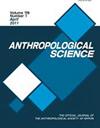A case study of cut marks on camelid bones from the El Palacio site in the northern highlands of Peru: implication of butchering activities
IF 0.8
4区 社会学
Q3 EVOLUTIONARY BIOLOGY
引用次数: 1
Abstract
South American camelids, which were domesticated in the Central Andes, have been emphasized for their secondary uses (e.g. llamas as pack animals and alpacas for their wool). In modern pasto ral societies the use of mature animals for meat is not efficient. However, it is interesting that cut marks have often been found on archaeological animal bones. This study aimed to describe butchering of camelids through macroscopic observation of cut marks in the Middle Horizon period, during the Wari Empire (600–1000 CE), when the use of camelids reached its peak, and to test whether these activities are consistent with ethnoarchaeological and ethnographic findings. The materials used here are camelid bones with cut marks from El Palacio in the northern highlands of Peru. They were assigned to Middle Cajamarca Phases B and C, and a part of the Late Cajamarca Phase (800–1000 CE). In this study, cut marks on animal bones were observed by macroscopy, and analyses were focused on their distribution, frequencies, and direction. Cut marks on camelid bones from El Palacio were observed over the entire body, suggesting that these marks were caused by dismembering, skinning, and extraction of meat, fat, and marrow. The frequencies of cut marks on camelid bones at El Palacio was 1.3%, lower than that in the Formative Period. This lower frequency might have been caused by more fragmented bones in the former. Furthermore, it is possible that the use of secondary products was emphasized at El Palacio. Cut marks were concentrated on the ventral side of each bone. This can be attributed to the butchering pro cedure described from ethnoarchaeology and ethnography, in which animal was turned on its back for dismemberment and removal of its internal organs from the ventral side, being careful not to soil the earth for ritual considerations.秘鲁北部高地埃尔帕拉西奥遗址骆驼骨骼上的切割痕迹的案例研究:屠宰活动的含义
在安第斯山脉中部驯化的南美骆驼,其次要用途被强调(例如,作为驮畜的大羊驼和用于羊毛的羊驼)。在现代畜牧社会中,利用成熟动物作为肉类的效率不高。然而,有趣的是,在考古动物的骨头上经常发现切割的痕迹。本研究旨在通过对中地平线时期(Wari Empire,公元600-1000年)切割痕迹的宏观观察来描述对骆驼的屠杀,当时骆驼的使用达到了顶峰,并测试这些活动是否与民族考古学和民族志研究结果一致。这里使用的材料是来自秘鲁北部高地El Palacio的带有切割痕迹的骆驼骨。他们被分配到中期卡哈马卡阶段B和C,以及后期卡哈马卡阶段(800-1000 CE)的一部分。本研究通过显微镜观察动物骨骼上的切痕,重点分析其分布、频率和方向。在El Palacio发现的骆驼骨骼上的切割痕迹遍布整个身体,这表明这些痕迹是由肢解、剥皮和提取肉、脂肪和骨髓造成的。El Palacio骆驼骨骼上的切割痕迹频率为1.3%,低于形成期。这种较低的频率可能是由于前者的骨头碎片较多。此外,埃尔帕拉西奥会议可能强调了二次产品的使用。切痕集中在每块骨头的腹侧。这可以归因于民族考古学和民族志中描述的屠宰程序,在这个过程中,动物被翻过来肢解,并从腹部取出内脏,为了仪式的考虑,小心翼翼地不弄脏泥土。
本文章由计算机程序翻译,如有差异,请以英文原文为准。
求助全文
约1分钟内获得全文
求助全文
来源期刊

Anthropological Science
生物-进化生物学
CiteScore
1.50
自引率
0.00%
发文量
7
审稿时长
>12 weeks
期刊介绍:
Anthropological Science (AS) publishes research papers, review articles, brief communications, and material reports in physical anthropology and related disciplines. The scope of AS encompasses all aspects of human and primate evolution and variation. We welcome research papers in molecular and morphological variation and evolution, genetics and population biology, growth and development, biomechanics, anatomy and physiology, ecology and behavioral biology, osteoarcheology and prehistory, and other disciplines relating to the understanding of human evolution and the biology of the human condition.
 求助内容:
求助内容: 应助结果提醒方式:
应助结果提醒方式:


